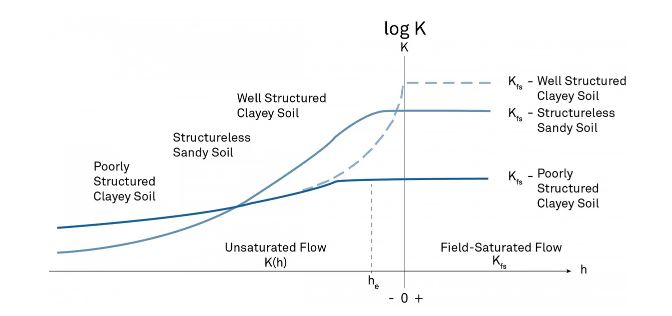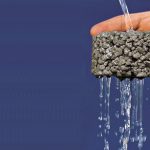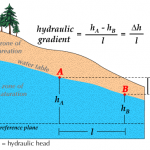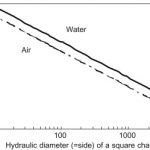
Hydraulic conductivity is an important concept in the fields of hydrology and hydrogeology. Also, it is a key parameter utilized by geotechnical engineers for soil and other material analysis. In this article, we explore the meaning of hydraulic conductivity, review its values for common materials, and compare it to permeability.
What is Hydraulic Conductivity
Hydraulic conductivity refers to the rate at which water, or any fluid, passes through soil or any other porous media. High conductivity values are indicative of a permeable material that easily allows fluid flow, whereas a low conductivity value depicts low permeability. Its value depends on the properties of the medium and that of the fluid. These properties include the intrinsic permeability and saturation of the medium/soil- while for the fluid, its viscosity and density determine conductivity. As a result, water at a particular site could experience varying levels of conductivity because of changes in the soil structure due to layering, lamination, and weathering. Understanding these changes in hydraulic conductivity is key to several professions.
Why is Hydraulic Conductivity Important
As hydraulic conductivity is a key factor in determining water flow in the soil, geotechnical engineers use it a lot in their projects. For instance- when excavating below groundwater levels, soils having high conductivity will demand more dewatering pumping than soils with low conductivity. Also, a soil with high conductivity will dissipate excess pore pressure quickly after application of a load. As a result, the shear strength of the soil increases, providing a more stable foundation for structures. Alternatively, low conductivity values means that the soil cannot quickly dissipate the excess pore pressure. Rather, it does this slowly over an extended period. Thus, reducing the shear strength of the soil and making room for instability or failure of structures. Insight into soil mechanics is useful in the design of retaining walls, foundations, slopes, and embankments.
Other professionals such as hydrologists use knowledge of conductivity for soil modelling, while researchers use it to determine soil health. In agriculture, it serves in calculating irrigation rate, predicting erosion, and soil leaching. Moreover, hydraulic conductivity is used to determine the efficacy of landfill cover.
Formula
Theoretically, Darcy’s Law provides the universal expression for groundwater flow in a certain area. The equation gives the volumetric flow rate (Q) through a medium as a function of hydraulic conductivity (K), cross-sectional flow area (A), and the hydraulic gradient (dh/dl).
![]()
From dimensional analysis of this equation, hydraulic conductivity is expressed as a function of distance over time. This could be meters per second, feet per second, or gallons per day.
Conductivity Values for Common Materials
Hydraulic conductivity is a key concept when dealing with materials, and varies according to the type. This section reviews its value in some common materials.
Hydraulic Conductivity of Soil
Soil may either be in a saturated or unsaturated state, so have a conductivity value depending on their state. There are several ways of checking this value, one of which is using lab tests to create conductivity curves that show the value at different levels of saturation, as in the following figure.

In the graph above, the horizontal axis indicates waterhead values, while the vertical axis shows conductivity values. The poorly structured clayey soil has the lowest saturated conductivity value because its small pores create more restrictions for flow paths. But a well-structured clayey soil contains aggregate with large pores, resulting in clearer flow paths and higher conductivity value. This is why clay has a wide range of conductivity values, typically from 8×10-13 to 4.7×10-9 m/s.
Hydraulic Conductivity of Sand
Sand is an important part of constituent of concrete, as well as well as part of most soil in different locations. Also, there are different categories of sand, meaning that its hydraulic conductivity varies as the table below shows.
| Type of Sand | Hydraulic Conductivity (m/s) |
| Coarse | 9×10-7 to 6×10-3 |
| Medium | 9×10-7 to 5×10-4 |
| Fine | 2×10-7 to 2×10-4 |
Conductivity of Gravel
Because the grain size of gravel is much larger than sand and other types of soil, there are more pores for water to pass through. So, it has higher conductivity values, typically between 3×10-4 and 3×10-2 m/s.
Conductivity of Rocks
The movement of water through rocks is different from what is obtainable in other soil types. For other soil types, flow is intergranular, which is in-between the soil particles. Whereas for rocks, water passes through fractures, fissures, or any discontinuities within the rock mass. So, if there are no fractures, conductivity is very low. Predicting fluid flow in rocks is complex due to changes in the fracture size, direction, and frequency over time. As these variables are not the same for different types of rocks, their hydraulic conductivity values are different as the table below shows.
| Rock Type | Hydraulic Conductivity (m/s) |
| Fractured igneous and metamorphic rocks | 8×10-9 to 3×10-4 |
| Unfractured igneous and metamorphic rocks | 3×10-14 to 2×10-10 |
| Weathered granite | 3.3×10-6 to 5.2×10-5 |
| Weathered gabbro | 5.5×10-7 to 3.8×10-6 |
| Basalt | 2×10-11 to 4.2×10-7 |
| Permeable basalt | 4×10-7 to 2×10-2 |
| Limestone and dolomite | 1×10-9 to 6×10-6 |
| Karst and reef limestone | 1×10-6 to 2×10-2 |
| Sandstone | 3×10-10 to 6×10-6 |
| Siltstone | 1×10-11 to 1.4×10-8 |
| Shale | 1×10-13 to 2×10-9 |
Hydraulic Conductivity vs Permeability
Because of their similarity, it is easy to misjudge the concepts of hydraulic conductivity and permeability as being the same. Whenever the values of conductivity or permeability are high, there is expectation of an equally high fluid flow rate. But this is not the case all the time. Why? Permeability is a function of only the flow path geometry. So, if a material has large pores between particles, it means its permeability is high. On the other hand, hydraulic conductivity is determined by the features of both the material/flow medium and the fluid. Thus, making it a more wholistic parameter as it considers both elements involved in a fluid flow. In summary, a material with high permeability may not deliver high flow rate due to the viscosity or density of the fluid flowing through it. However, high conductivity values always deliver high fluid flow rate.



